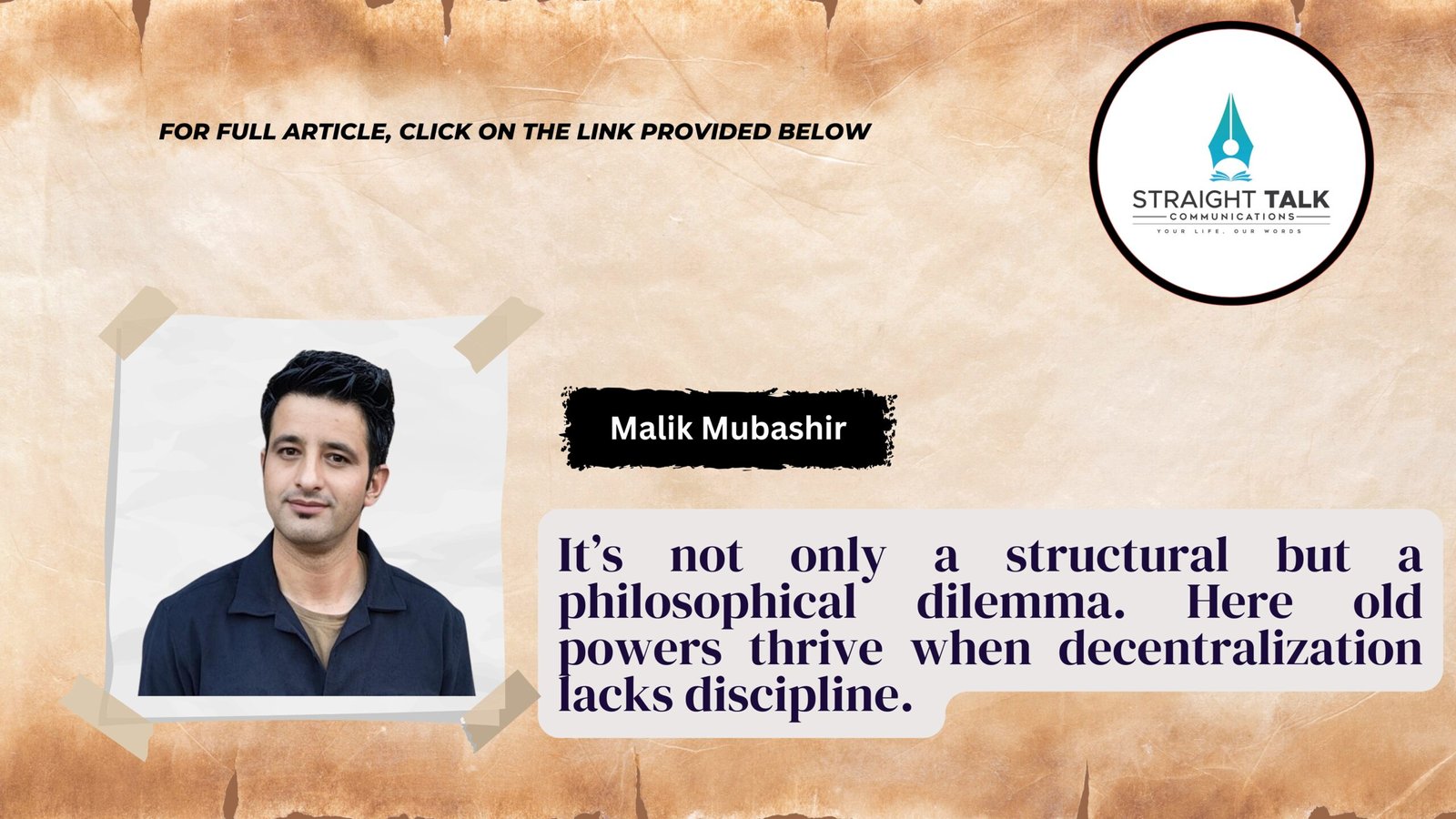A dilemma of friction between centralization and decentralization

It’s not only a structural but a philosophical dilemma. Here old powers thrive when decentralization lacks discipline.
Malik Mubashir
In the vast discourse of organizational management, the friction between centralization and decentralization is not merely a structural dilemma but a philosophical one. It is not only about how institutions govern complexity, human behaviour and evolving cultures but it defines how institution will evolve.
Analogy can be drawn between centralisation & a giant tree in a park whose expansive canopy dominates the landscape, providing order, stability and a tightly managed ecosystem. Underneath which no other plant, be it a flowering idea or a disruptive weed can grow freely. The system is controlled, uniform and safe from infiltration, but at the cost of diversity and innovation.
In contrast, decentralisation is like an eco-friendly garden which opens the space for all plants whether vibrant flora or aggressive weeds to thrive. Thus on one hand decentralisation enables diversity of thought, nurtures innovation and decentralises power, but on other side there lies the paradox as in the said ecosystem while flora may blossom, so too can the weeds, if left unchecked.
Historically, many institutions especially in the public and semi-public spheres have been plagued by cronyism were cortiree culture, rooted in personal loyalties and informal influence have corrupted systems by side-lining merit and institutional integrity. In response, centralisation was not just a structural shift but a systemic reaction & a necessary firewall to detox the organisational terrain.
Thus in order to supress the overt dominance of cortirees, key decisions were centralised, autonomy was curbed and scrutiny intensified. The leaders with business acumen & foresightedness phase out the individuals which were the key architects of earlier crony system .However at times due to the limited access to business intelligence, the leader in control cannot clearly wipe out the crony network as few among the key architects of earlier crony systems are so adaptive that they find ways to camouflage themselves. They survive, not by resisting centralisation, but by mastering its language and appearing loyal, efficient and aligned with the new order.
The presence of these cultural constants (adaptive weed) introduces a deeper challenge for leadership as these individuals or groups survive, thrive and lead irrespective of ideological or structural shifts. Since they possess a camouflage tendency, an ability to adapt, disguise and reflect the colour of the master in power. The challenges have quadrupled as these cultural constants have developed a systemic impunity as they are the same individuals who held influence during the era of cortiree dominance, transitioned smoothly into centralised reforms and now stand at the helm as decentralisation becomes the new mantra.
Under centralisation, their survival was often benign as the system’s rigidity did not allow this weed to exercise disruptive autonomy though they could persist, but not proliferate. But under laissez-faire style of leadership, were members are allowed to make decisions, the risk intensifies. As these disguised constants may reclaim influence, not by openly opposing reforms, but by quietly subverting it from within, eventually eroding the very culture decentralisation aims to foster.
Here it is pertinent to highlight that decentralisation is built on trust, but unchecked trust in legacy power holders, especially those with a record of adaptability for survival rather than transformation, can be catastrophic. These actors may quietly outnumber and overshadow the genuine contributors, using their strategic positioning, network leverage and institutional memory to subtly re-establish control though this time under the garb of empowerment.
For every stakeholder, more than a structural concern this can be an existential challenge. If decentralisation enables such individuals to evolve unchecked, the result will not be a participatory governance but decentralised capture. Further it would nullify the costs already incurred under centralisation in systems, processes and cultural re-engineering that sought to root out old rot.
Thus it is imperative for a laissez-faire leader to go beyond organisational charts. It must begin to dwell deeply on how certain behavioural constants persist across regimes, why some individuals are always at the centre of power and what psychological or strategic traits allow them to adapt without transforming.
Decentralisation must not mean decontrol but it must be a conscious design of empowerment where autonomy is matched by accountability and cultural audits are conducted with as much seriousness as financial ones. Leaders must identify not just the “visible weed” but the strategic mimicry of those who have learned to bloom like the flower but still carry the root of disruption.
There is also a call for institutional memory management which will ensure that the past does not quietly embed itself into the future through familiar faces and patterns that were once part of the problem. Thus the transition from centralisation to decentralisation is not mere shift in structure but it is a shift in consciousness. It demands a vigilant eye, an understanding of historical behavioural patterns and a clear-eyed approach to who gets empowered and why.
As they say and we must remember that in the garden of governance, freedom without filters may allow weeds to bloom faster than the flora. Leaders must ensure that decentralization does not become a new robe for old coterie and that the organization does not become hostage again to those it once tried so hard to weed out.







